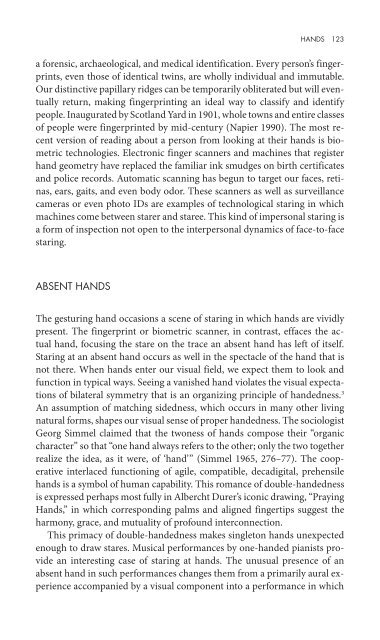Staring how we look sobre la mirada.pdf - artecolonial
Staring how we look sobre la mirada.pdf - artecolonial
Staring how we look sobre la mirada.pdf - artecolonial
You also want an ePaper? Increase the reach of your titles
YUMPU automatically turns print PDFs into web optimized ePapers that Google loves.
KNOWLEDGE GATHERING 57<br />
Weegee himself confessed to being “spellbound by the mystery of<br />
murder.” His photos present less the murdered and more the fascination<br />
itself embodied in the spectators he framed with his camera (1996, 13).<br />
In his photos of watching crowds, Weegee often p<strong>la</strong>ces his camera in the<br />
position of the spectacle—the fire, the dead body, or the wrecked car—in<br />
order to seize frontally the faces of the crowd mesmerized by the spectacle<br />
his picture never reveals. These photos frequently foreground the contorted<br />
faces of children elbowing up to the front for a better view. “Their First Murder,”<br />
for example, s<strong>how</strong>s a gang of children jockeying for position to stare at<br />
something in front of them but behind the camera (see figure 5.1). Their disturbed<br />
and disturbing expressions contrast with the generally more impassive<br />
stares of the adults around them. The caption under another group of eager<br />
children surrounding a <strong>we</strong>eping woman says, “A woman re<strong>la</strong>tive cried . . . but<br />
neighborhood dead-end kids enjoyed the s<strong>how</strong> when a small-time racketeer<br />
was shot and killed” (1945, 86). Revealing children as the most eager starers<br />
seems to confirm that staring is a primal impulse not yet fully tempered<br />
in these children. Admonishments not to stare have thus far not overridden<br />
enthrallment and leashed them up with polite restraint.<br />
We might characterize what psychologists and physicians think of as the<br />
search for dopamine-induced pleasures of visual novelty as instead baroque<br />
stares of wonder. This is an impulse not just to <strong>look</strong> but also to know what happened,<br />
to get the story, to wonder about a wonder. <strong>Staring</strong> gratifies our craving<br />
for visual stimu<strong>la</strong>tion: it satisfies our hungry brains. Stareable sights such<br />
as our image in the mirror or a dead body offer urgent knowledge gathering<br />
expeditions. Yet staring at one another complicates the thrill of intense <strong>look</strong>ing.<br />
Because <strong>we</strong> are vulnerable and exposed in interchanges of mutual <strong>look</strong>ing,<br />
social order evolves toward regu<strong>la</strong>ting, even ritualizing, visual re<strong>la</strong>tionships, as<br />
<strong>we</strong> have seen. <strong>Staring</strong> among strangers, the very site of greatest potential for<br />
chancing upon human novelty, has in contemporary American culture come<br />
to be seen as untoward, a vio<strong>la</strong>tion of the strict rules that govern social interaction.<br />
Baroque staring, then, gets us what <strong>we</strong> want but it also gets us into trouble<br />
when <strong>we</strong> direct it toward our fellow citizens. This contradiction makes staring<br />
compelling and fraught human behavior.<br />
THE PERILS OF BAROQUE STARING<br />
The staring encounter can be a tangle of desire and dread for starer and<br />
staree alike. Although <strong>we</strong> think of staring as an affront to starees, starers<br />
suffer a <strong>we</strong>lter of psychological contradictions as <strong>we</strong>ll. Confrontations with<br />
illegible bodies interrupt our reveries on the mundane visual <strong>la</strong>ndscape. On


